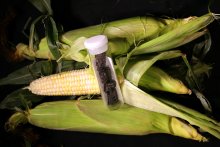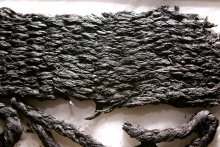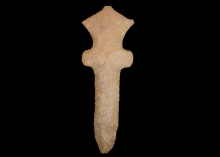Growing a New Way of Life (4,000-600 years ago)
Native American gardeners domesticated a variety of native plants, producing surplus food and storing it for later consumption. This new way of life was accompanied by technological advancements such as pottery, more trade, and changes in social organization and religion. By 900 years ago, maize, a tropical grass hybrid from Mexico, was grown in Illinois. Maize production required more labor but yielded more food, both of which sparked population growth and unprecedented changes in every aspect of Native American life. Illinois’ first metropolis, Cahokia, a community of perhaps 20,000 people, commanded the economic, social, and political landscape of the Midwest for nearly three centuries.
Despite the best efforts of archaeologists, serendipity often plays a role in the most significant finds. In the case of the Mackinaw Cache, a group of boys hauling gravel on a farm near Mackinaw in 1916 uncovered about 40 spectacular “bifaces” on the slope of a hill just a quarter of a mile from the Mackinaw River. A biface is a stone implement that has been worked on both sides.
It’s a story that was disturbingly familiar at the turn of the 20th Century. The Carolina Parakeet once was found in abundance throughout the eastern and Midwestern United States. The parrot with the northern-most distribution, the colorful and noisy Carolina Parakeet was hard to miss when it gathered in large flocks. By the late 19th century it was rare. By the early 20th century it was virtually extinct, with the last known individual dying in captivity in 1918.
To understand the significance of the invention of pottery, consider the modern Sunday barbecue where one might hear the sizzle of grease from the hamburger as it drips through the grill and into the fire. But for Native people, the fat going up in smoke represented the loss of crucial calories. Hunters spent hours of physical exertion stalking, killing, butchering, and transporting their game home. Meats and other foods were then cooked by placing the pot in a fire with no loss of those hard-won calories.
This carbonized, woven fabric was recovered in 1974 during archaeological excavations at the Newbridge site in Greene County, Illinois, by Northwestern University. Perhaps part of a fringed skirt, the fabric is approximately 1150 to 1450 years old, dating from the early portion of the Late Woodland period.
This small sandstone tablet, only about four inches tall, shows a man in a bird costume (possibly representing an eagle or peregrine falcon). The reverse side features a crosshatch design that may depict a snakeskin.














